Enterprise Project Management Software (EPM Software) refers to a set of tools and systems designed to help organizations manage and track large-scale projects and portfolios across multiple departments or business units.
Discover the top 12 best Enterprise Project Management Software (EPM Tool)
Asana
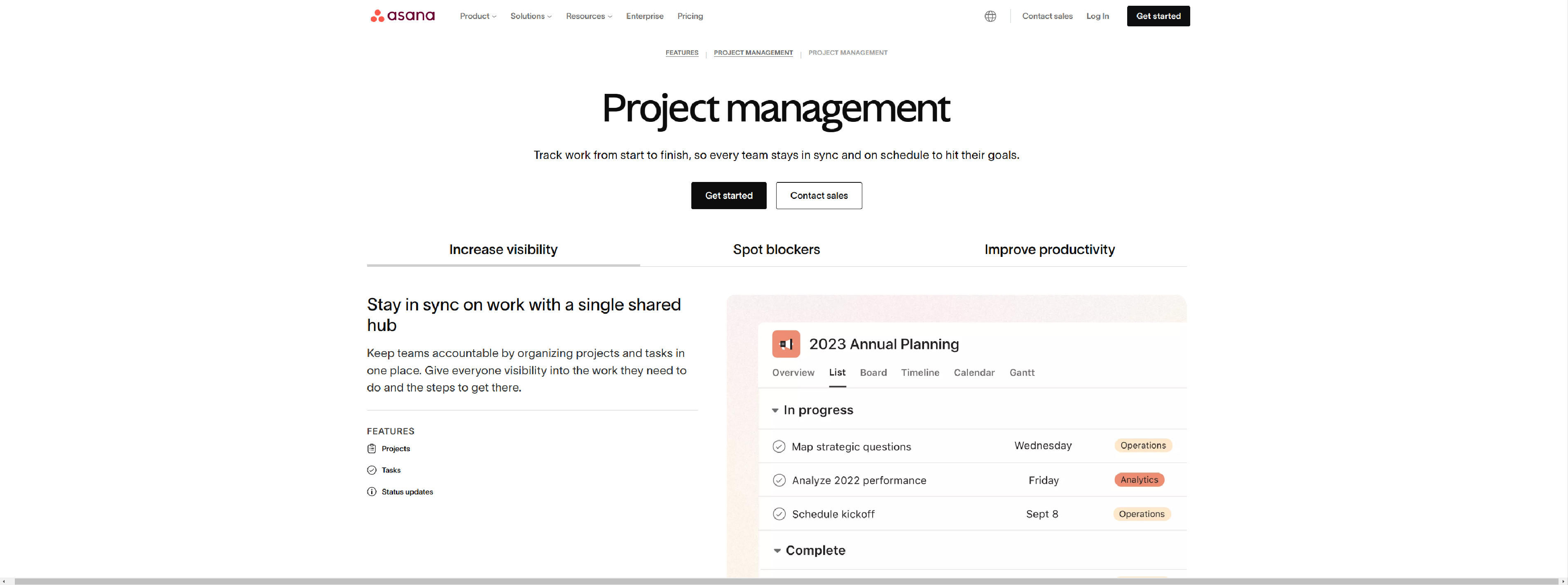
Asana – Track work from start to finish with Asana’s project and task management features, so every team stays in sync and on schedule to hit their goals.
- Organize tasks and tackle work together in a shared hub
- See your work as a list, calendar, timeline, Gantt chart, or Kanban board
- Break work into bite-size pieces with clear owners and due dates
- Add labels to tasks so you can sort, filter, and automatically report on work
- Craft project updates in minutes with time-saving automations
- Get automatic updates about work that matters to you, and filter out the rest
- See all your assignments in one place, so you can prioritize what’s next
- It’s all here. Jump right in with an overview of your most important work
- Take Asana from your door to your desk without missing a beat
- Measure how much time you’re spending on work, so you can correctly budget the time you need
Wrike
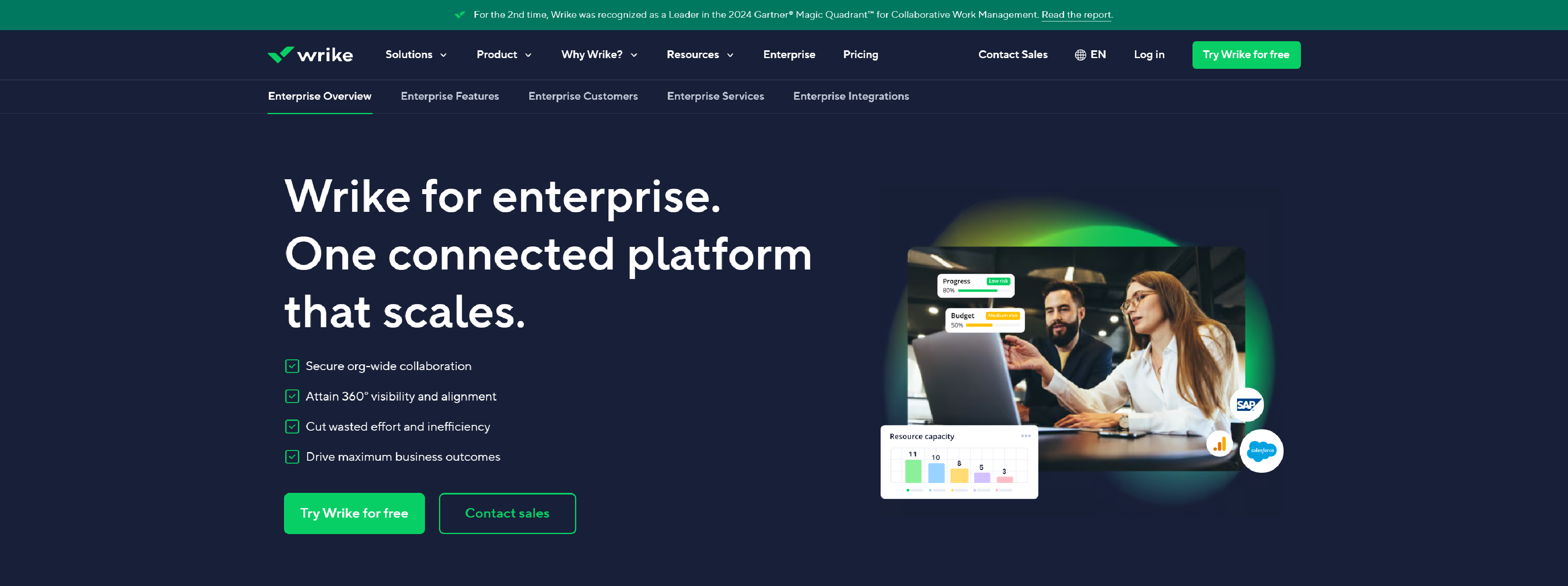
Wrike – Connect and automate cross-functional team processes enterprise-wide with our cutting edge intelligent and secure work management platform.
- Workflow automation and integrations
- Unmatched data security and controls
- Unparalleled resource management
- Boundless user integration
- End-to-end work management
- Advanced tools for collaboration
- Work Intelligence
Scnsoft
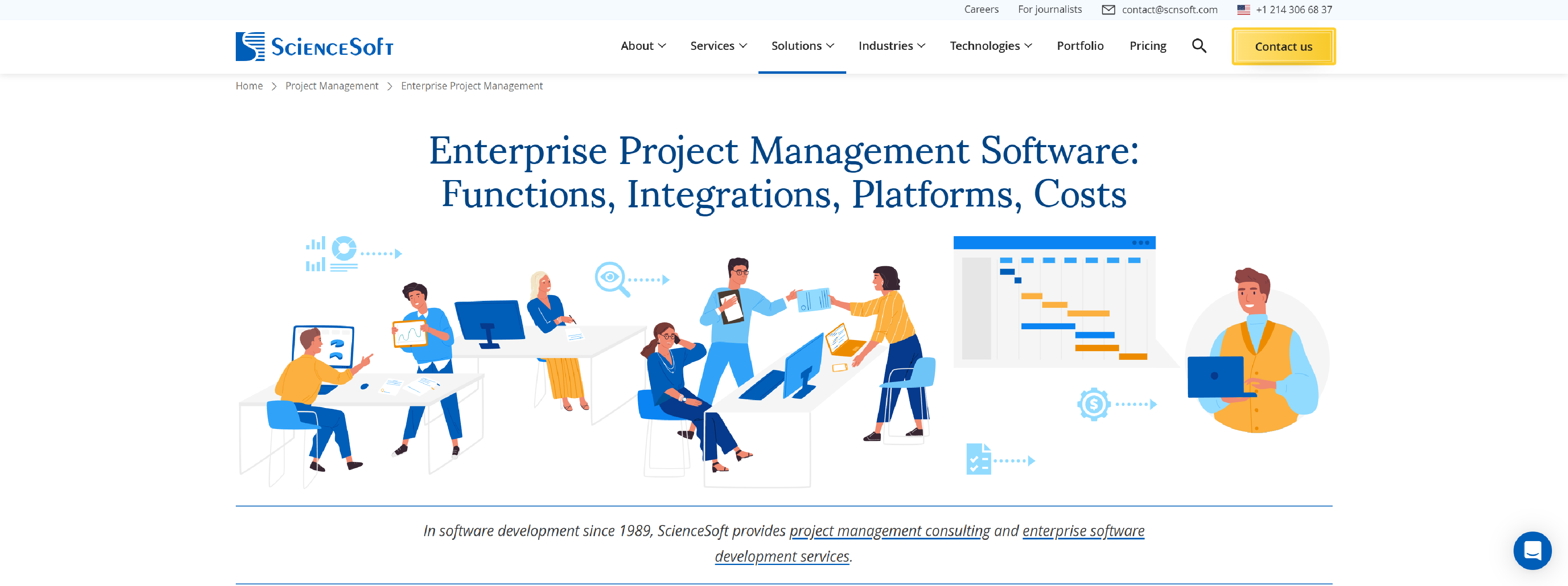
ScienceSoft shows features, integrations, costs of enterprise project management software, and lists popular tools for it.
- Project planning
- Project monitoring
- Human resource management
- Financial resource management
- Physical resource management
- Time management
- Project risk and issue management
- Project intake and demand management
- Project analytics
- Gantt charts
- Project collaboration
Adobe
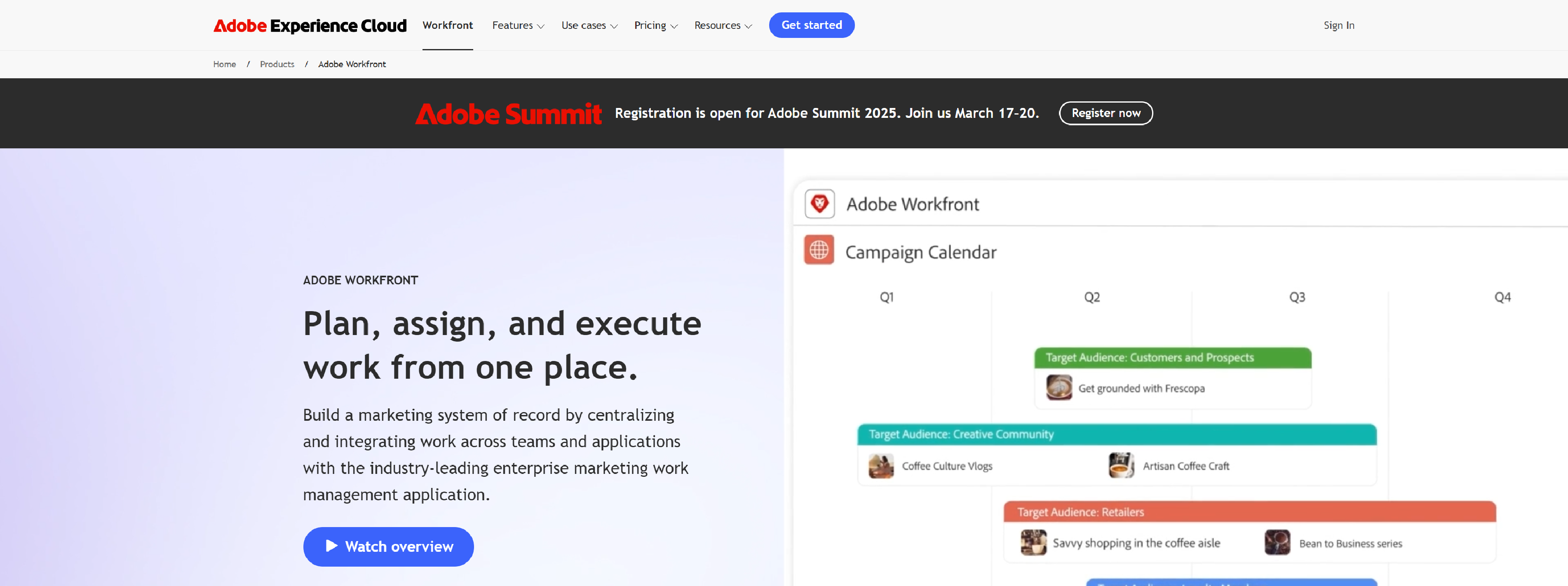
Streamline workflows, optimize resources, and improve project outcomes with centralized project management and comprehensive reporting on Adobe Workfront.
- Streamline enterprise planning
- Connect teams and tools
- Automate workflows
- Accelerate reviews and approvals
- Measure and report insights
Wetrack
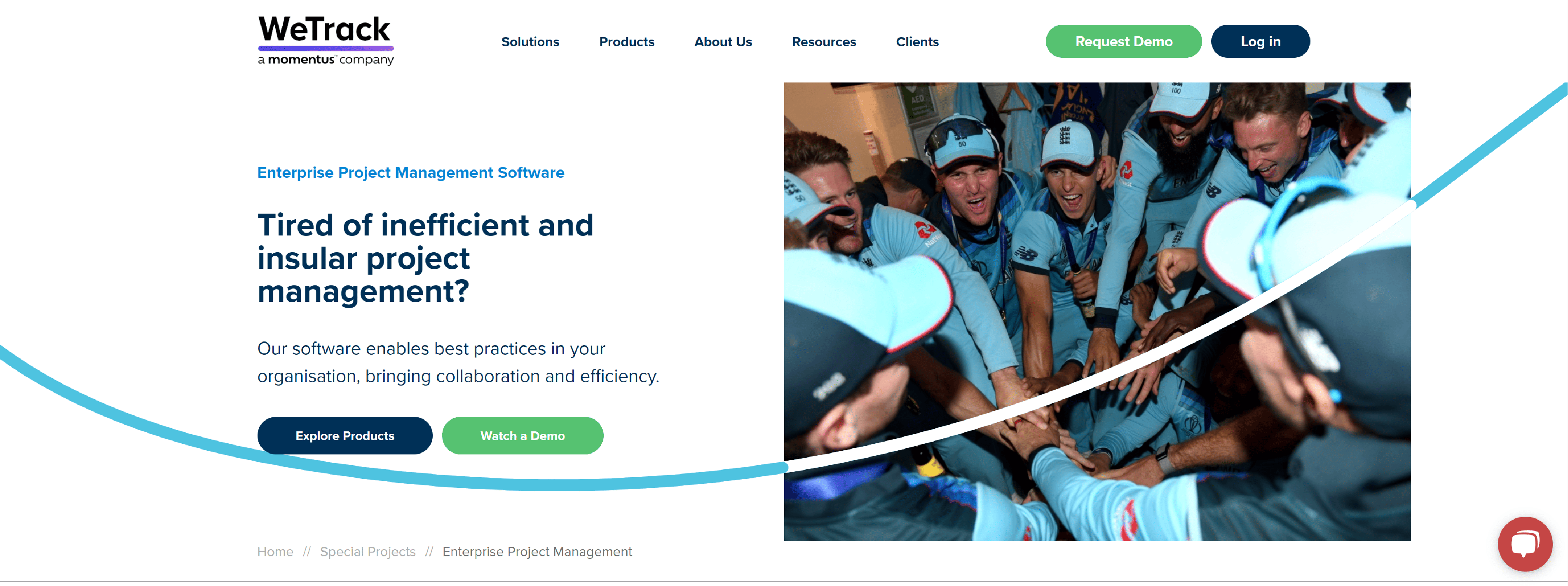
Plan better and collaborate better within your organisation, using WeTrack’s enterprise project management software to provide consistency to your work.
- Solid foundations: scrutinising existing plans, making improvements and rolling out to your team
- A single hub to collaborate on and track your diverse set of programmes and portfolios
- Milestone management, dependencies and Gantt charts to give a greater understanding of how work sits across the organisation
Birdviewpsa
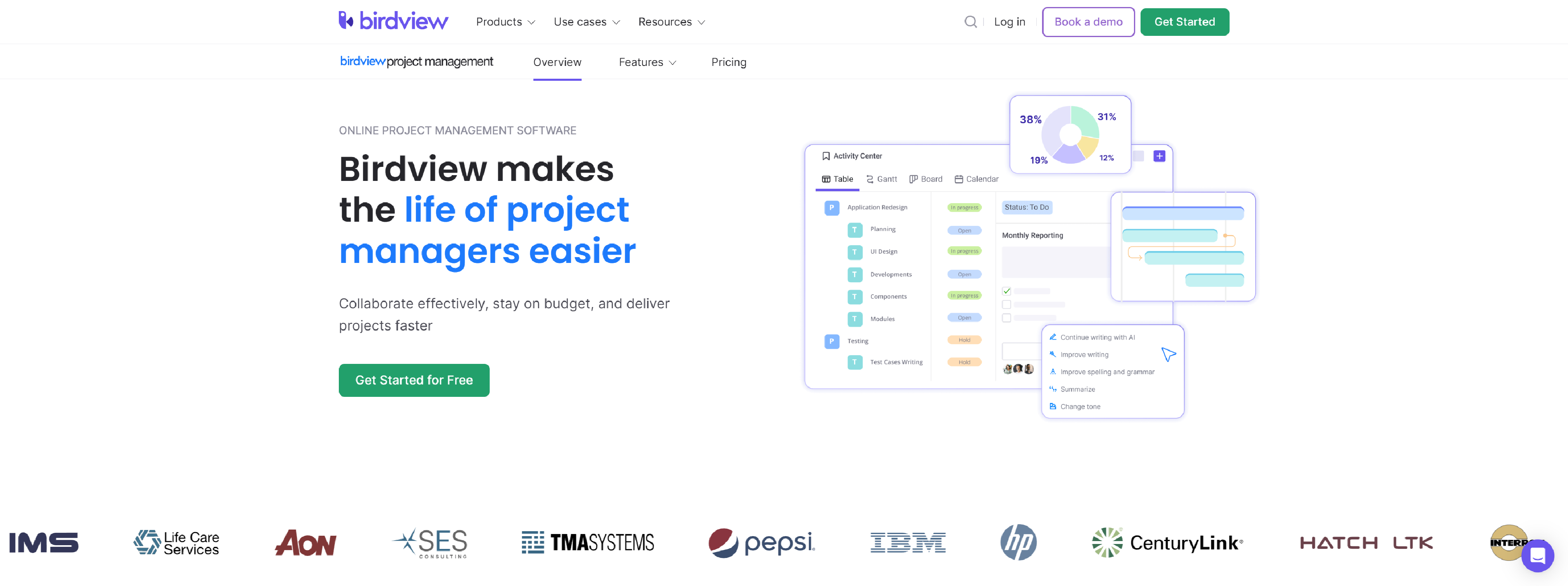
Birdview is designed to evolve alongside your business and team, adapting to your changing needs as you grow.
- Visibility for every stage of every project
- See everything in one place
- Give team collaboration a boost
- Leverage the power of AI
- Seamlessly integrate with your existing tool
Hive
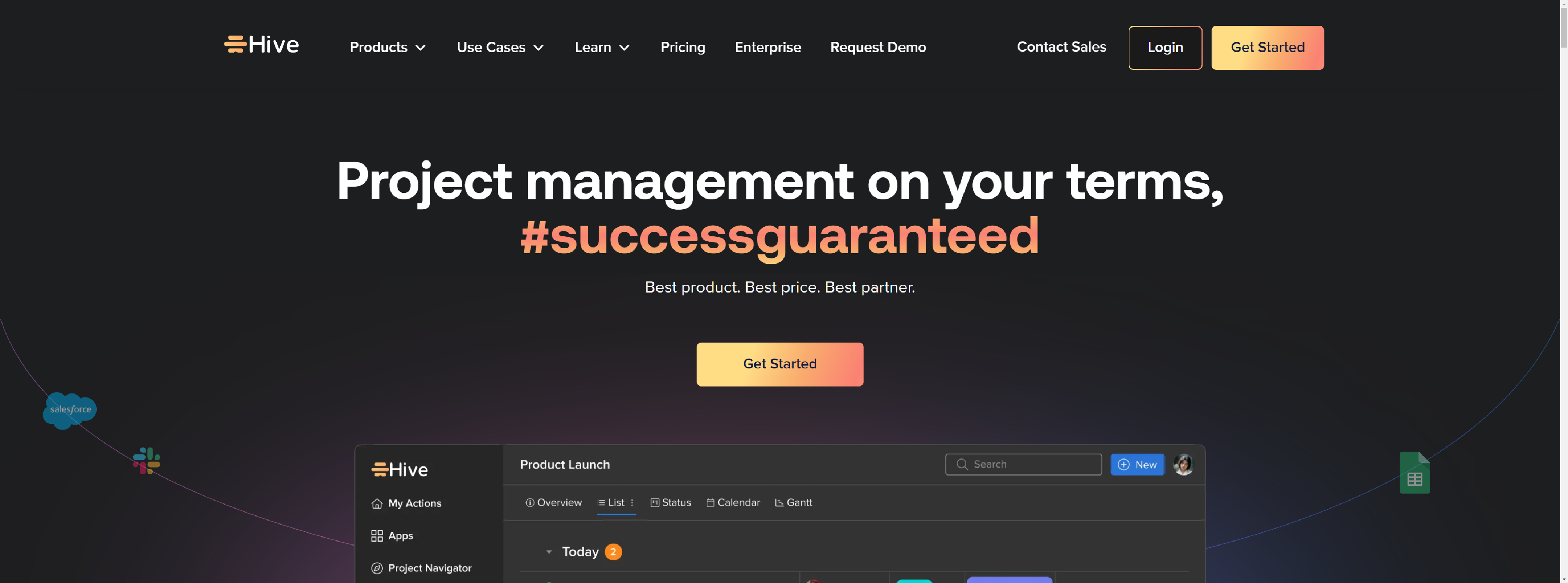
Hive’s project management software to manage your projects, track tasks and collaborate with teams of any size.
- Manage every project in one place
- Central meeting place for your team & your projects
- Complex projects easy
- Connect with your team from anywhere
- Track team and project progress
- Get creative & make Hive your own
- Put your work on autopilot
- Gain visibility and gather insights
- Your tools should work together
Openproject
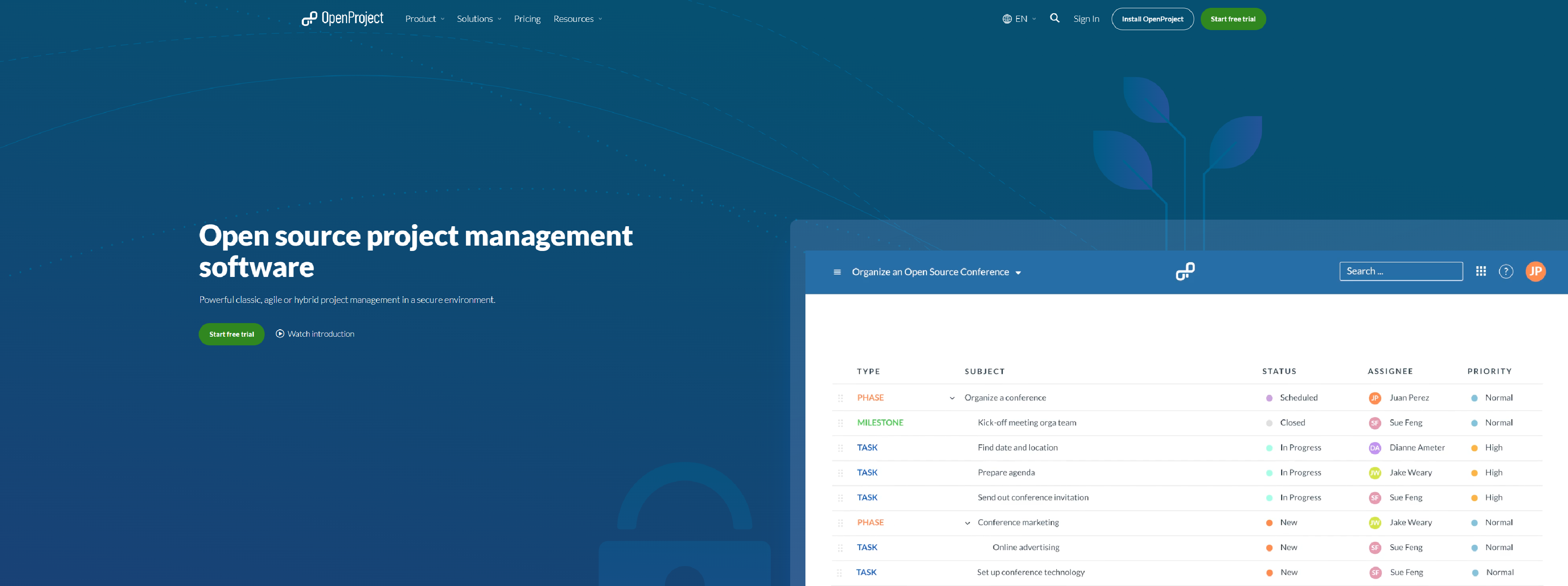
OpenProject as the leading open source project management software offers various features to support the management of an enterprise project landscape.
- Maintain control of your data and stay secure
- Your base for classic, agile or hybrid project management
- Leverage Open Source for yourself
- The leading open source project management software
- Enhancing project management efficiency
Proprofsproject
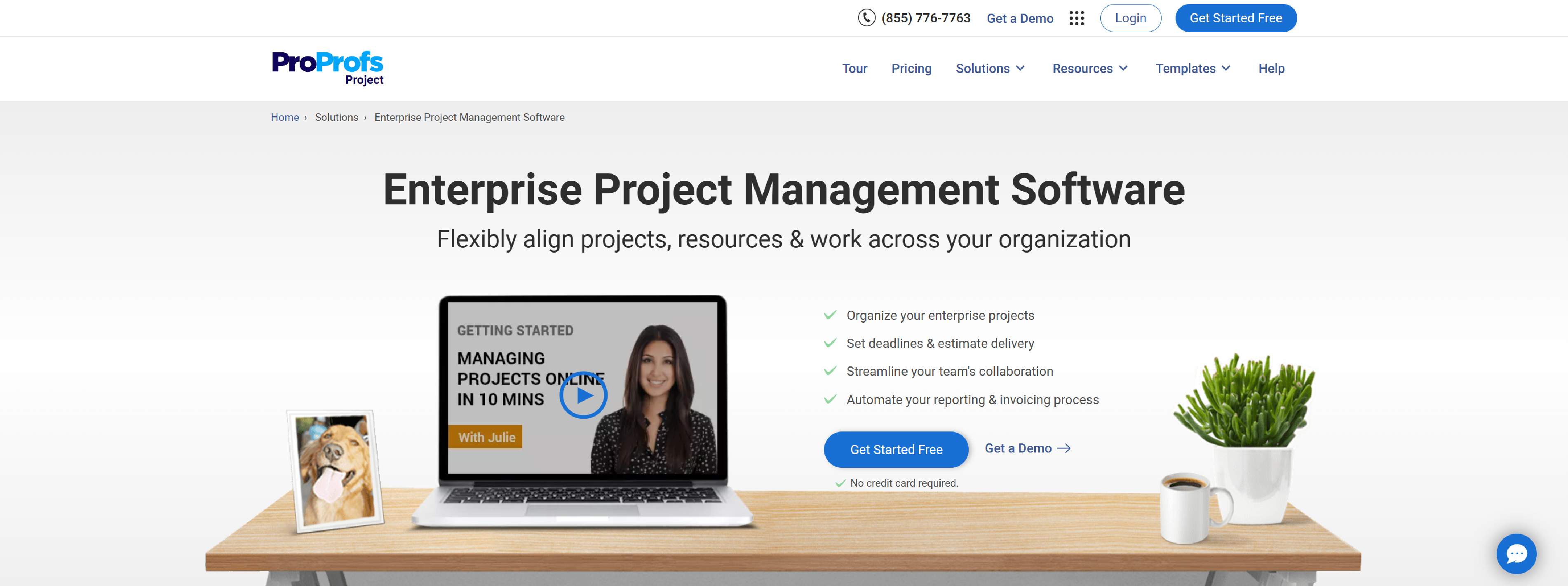
ProProfs Project is a simple yet powerful online project management software that helps your teams plan & track work, and collaborate on the go.
- Customize your project management experience with enterprise project management tool
- Track work progress & meet deadlines smoothly
- Stay connected & discuss projects on a single dashboard
- Generate intelligence analytics, reports & accurate invoices in no time
- Deploy Enterprise Project Management Software to Streamline Workflow
Smartsheet
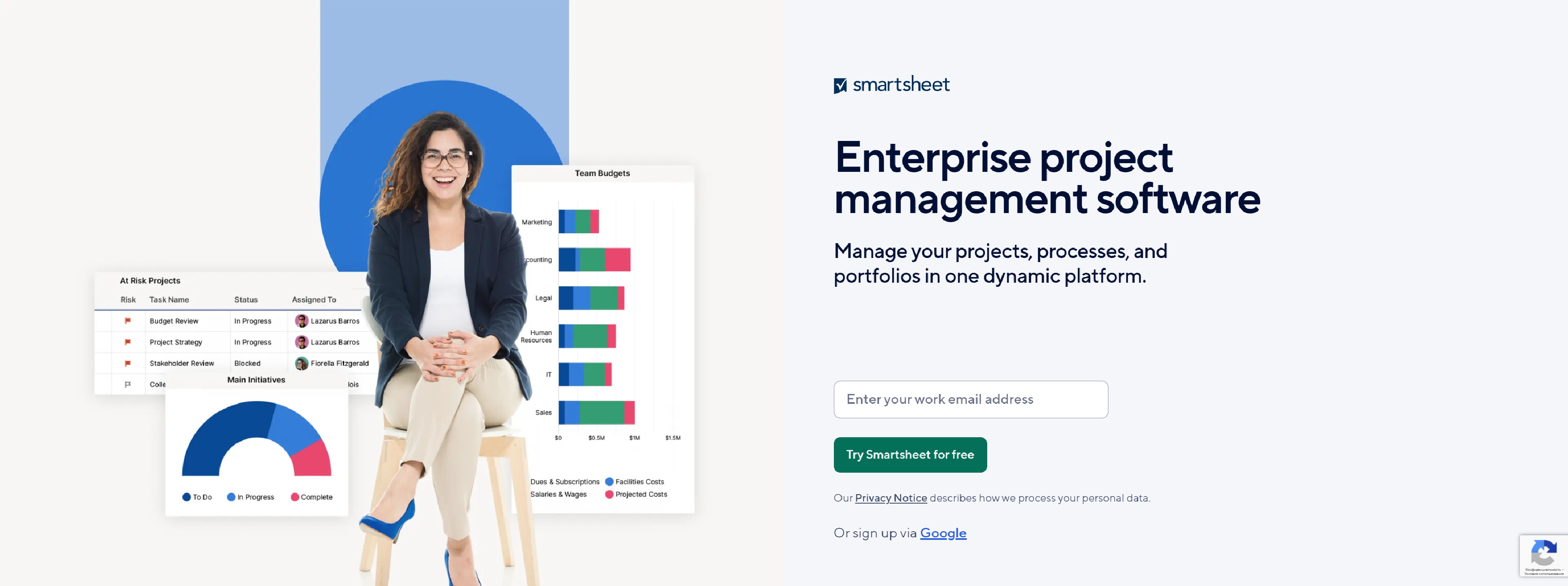
Smartsheet – Manage your projects, processes, and portfolios in one dynamic platform.
- Keep project plans & schedules on track
- Dynamic portfolio management
- Accelerate program planning & delivery
- Unlock real-time visibility for everyone
- Automate repetitive processes
- Visualize your projects with Gantt charts
Productive
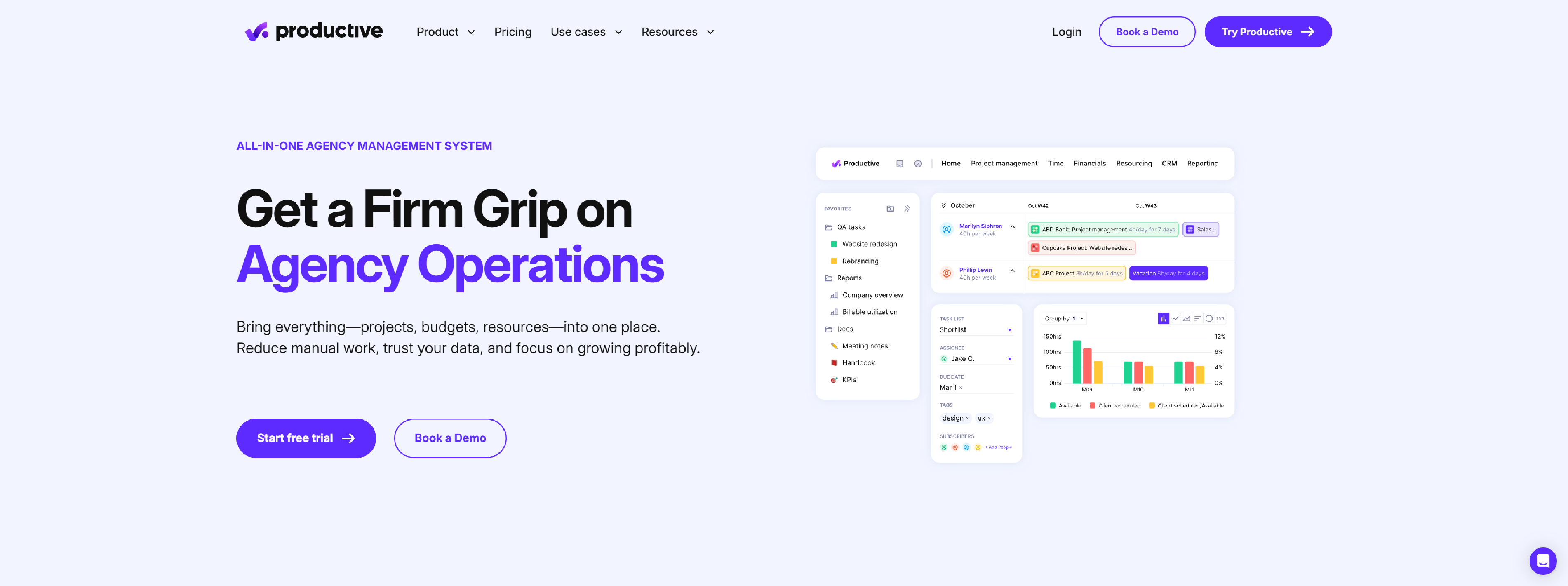
Run a profitable agency with Productive – the all-in-one agency management system for marketing, creative, software development and more.
- Easily visualize your project with key milestones and deliverables
- Cast an eye on tasks and filter them by name, due date, assignees, and more
- If you’re a fan of spreadsheets, tables and cells, simply apply the Table layout to view tasks
- If moving tasks around on a Kanban board is what you prefer most, choose the Board layout
- When timing is of the essence, use this layout for tasks. Add a specific due date or date range first
- Drag and drop, move tasks around, or expand and contract them to update start and due dates
- Check the workload of your teammates and delegate Tasks with ease
Teamhub
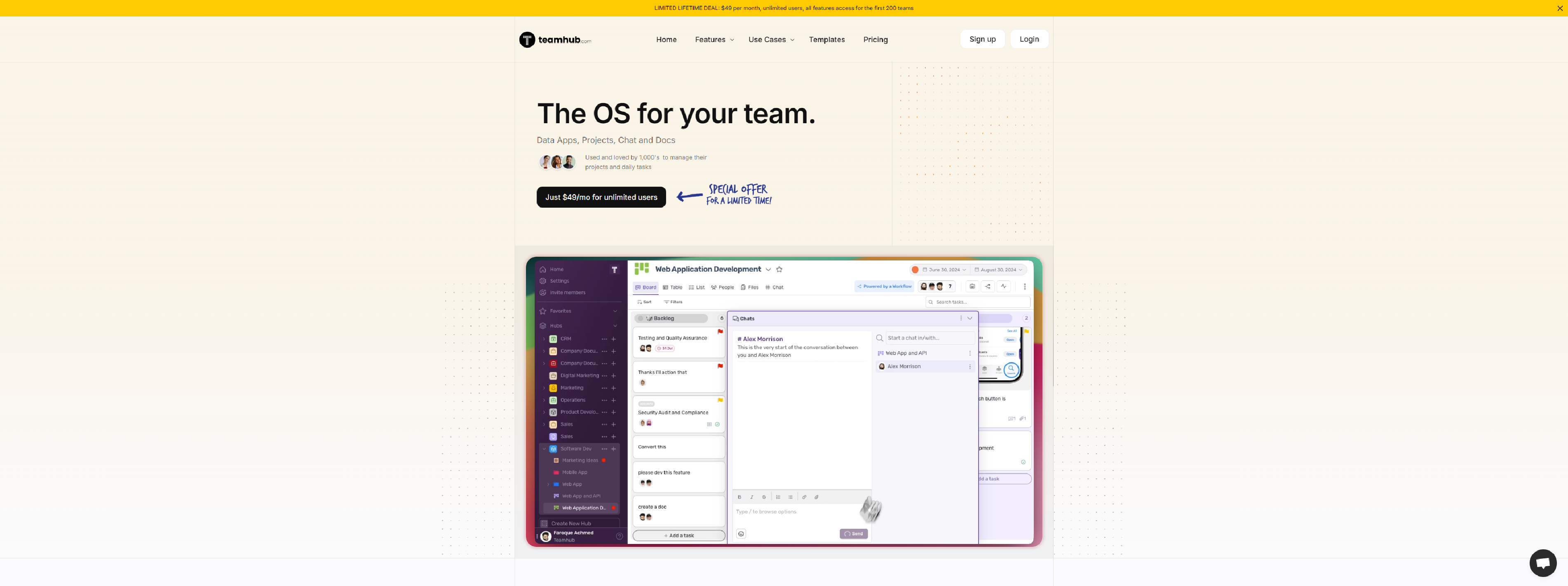
Teamhub – Efficiently plan, organize, and collaborate on any project with your team.
- View your tasks, your way. Kanban style view, excel like grid, traditional lists and tasks or people view
- Direct one-to-one chats or chat #channels with hundreds of team members. We provide the tools to help you get organized
- Use our beautiful block based editor to create structured docs and knowledge bases for your team
- Teamhub.com is made for your entire organization. Collaborate across departments and teams
- Get your project off to a flying start
What is an Enterprise Project Management Software?
Enterprise Project Management (EPM) software is a type of software designed to support the management of complex projects across large organizations. It provides a centralized platform that allows project managers and teams to plan, execute, and monitor projects from start to finish. This software is specifically built for enterprises, which often handle multiple projects simultaneously, across various departments, and with large teams of people involved.
At its core, EPM software helps organizations streamline project management processes, enhance collaboration, and maintain visibility into the progress of various initiatives. It ensures that projects are aligned with the broader business goals and helps manage resources, timelines, budgets, risks, and overall project performance.
What sets EPM software apart from more basic project management tools is its focus on scalability, integration, and the ability to handle multiple projects and portfolios at once. It serves not just as a tool for managing individual tasks or projects but also as a way to manage a portfolio of projects, ensuring that the right resources are allocated, risks are mitigated, and organizational priorities are met.
EPM software is typically used in industries like construction, engineering, IT, and manufacturing, where large, complex projects require extensive coordination. Its primary purpose is to provide an enterprise-wide view of project health, progress, and outcomes, allowing leaders to make informed decisions that contribute to the organization’s overall success.
The Strategic Advantages of Implementing Enterprise Project Management Software
Implementing Enterprise Project Management (EPM) software offers a range of strategic advantages that can significantly enhance an organization’s ability to manage complex projects, optimize resources, and align initiatives with broader business goals.
Improved Project Alignment with Business Goals
EPM software ensures that projects are aligned with the organization’s overall strategic objectives. By providing a centralized platform for project tracking, it enables decision-makers to prioritize projects based on strategic value, ROI, and long-term impact. This alignment helps prevent the execution of low-priority or misaligned projects that could divert resources from the organization’s core objectives.
Centralized Visibility and Real-Time Insights
A major advantage of EPM software is that it provides executives and project managers with a single, real-time view of all projects across the enterprise. This centralized visibility enables better tracking of key metrics such as timelines, budgets, resource usage, and project performance. With real-time insights, leadership can quickly identify issues, make informed decisions, and take corrective action before problems escalate.
Better Resource Management and Utilization
EPM software allows for the effective allocation of resources across multiple projects. By providing a clear view of available resources (human, financial, physical), it helps prevent overallocation or resource conflicts. Additionally, it helps project managers optimize resource utilization by ensuring the right people with the right skills are assigned to the right tasks at the right time, leading to higher productivity and reduced costs.
Enhanced Collaboration Across Teams
With multiple teams, departments, or even geographical locations involved in large-scale projects, collaboration can often be a challenge. EPM software facilitates seamless communication and collaboration through shared workspaces, task assignments, document sharing, and real-time updates. This collaborative environment ensures that team members are always on the same page, minimizing miscommunication and delays.
Better Risk Management
Risk management is a critical aspect of large projects, and EPM software can help identify, assess, and mitigate risks more effectively. By providing tools to track potential risks throughout the project lifecycle, the software allows teams to proactively address challenges such as schedule delays, budget overruns, and resource shortages. This proactive approach reduces the likelihood of project failures or unexpected setbacks.
Increased Efficiency and Productivity
EPM software streamlines many aspects of project management, automating repetitive tasks like reporting, time tracking, and budget monitoring. This reduces the administrative burden on project managers and teams, enabling them to focus on higher-value activities. The software’s ability to integrate with other enterprise tools (such as ERP or CRM systems) also reduces data silos and minimizes manual data entry, further improving operational efficiency.
Improved Financial Control
EPM software helps organizations maintain tighter control over project finances by providing detailed insights into budgets, actual expenditures, and forecasts. This enables project managers to track spending in real time and adjust as necessary to avoid overruns. Enhanced financial oversight also helps organizations prioritize projects that provide the greatest return on investment (ROI) and allocate funds where they are most needed.
Better Decision-Making Through Data and Analytics
EPM software provides powerful reporting and analytics tools that deliver actionable insights into project performance. With real-time data on project progress, resource usage, and financial health, executives can make more informed decisions. These insights enable leaders to adjust project plans, reallocate resources, and even pivot strategy if necessary, ensuring that the organization remains agile and responsive to changing conditions.
Scalability for Growing Organizations
As organizations grow and take on more projects, the complexity of managing them increases. EPM software is designed to scale with an organization’s needs, allowing it to handle a larger volume of projects, teams, and resources as the business expands. Whether an organization is managing a few projects or hundreds, EPM software can adapt to the size and complexity of the portfolio.
Compliance and Standardization
For organizations in regulated industries (e.g., healthcare, construction, finance), EPM software helps ensure that projects are executed in compliance with industry standards and regulations. The software can enforce standardized project management methodologies, such as PMBOK, Agile, or PRINCE2, helping ensure that projects follow best practices and meet legal, financial, and quality requirements.
Enhanced Competitive Advantage
Organizations that effectively manage their projects using EPM software are better positioned to execute on time, within budget, and with higher quality. This ability to consistently deliver successful projects can provide a significant competitive advantage, as it builds reputation, fosters customer loyalty, and drives business growth. In industries where speed and efficiency are key, the strategic advantages of EPM can differentiate an organization from its competitors.
Continuous Improvement and Organizational Learning
EPM software often comes with built-in analytics and reporting tools that allow organizations to learn from each project. By capturing data on project performance and outcomes, organizations can analyze past successes and failures to improve future project planning and execution. This creates a culture of continuous improvement, where processes are refined and best practices are established over time.
How To Choose the Best Enterprise Project Management Software
Choosing the best Enterprise Project Management (EPM) software is a critical decision for organizations, as it can greatly impact project success, team collaboration, and overall business performance. The right tool will streamline project workflows, improve resource utilization, and provide valuable insights into project performance. However, with so many options on the market, selecting the ideal software for your organization can be a complex process.
1. Define Your Organization’s Needs and Objectives
Before evaluating any software options, it’s crucial to understand what you need from an EPM solution. Ask yourself the following questions:
- What type of projects do you manage (e.g., IT, construction, marketing, product development)?
- How complex are your projects? Are you managing large portfolios with multiple teams and departments, or smaller, more straightforward projects?
- What specific project management methodologies do you follow (e.g., Agile, Waterfall, Hybrid)?
- Do you need advanced features like resource management, budget tracking, or risk management?
- How much emphasis do you place on collaboration, and do you need features like communication tools, document sharing, or real-time updates?
Once you have a clear understanding of your needs, you can begin evaluating software options based on how well they align with these objectives.
2. Scalability
EPM software must be able to grow with your organization. Consider how well the software will scale as your business expands or as the complexity of your projects increases.
- The ability to manage multiple projects and large portfolios simultaneously.
- Support for managing multi-team collaboration across departments or geographic locations.
- Flexibility in terms of user roles and permissions, allowing different levels of access for various stakeholders.
- The capacity to handle an increasing volume of data, tasks, and resources without compromising performance.
3. Ease of Use and User Adoption
The software you choose should be intuitive and user-friendly to ensure high adoption rates across your organization. If employees find the tool difficult to use, it could lead to resistance, incomplete data entry, and inefficient workflows.
- A simple, clean interface that’s easy for users to navigate, even if they are not seasoned project managers.
- Customizable dashboards to tailor the user experience based on different roles or preferences.
- A software training program or customer support options to ease the learning curve.
If possible, opt for software that offers free trials or demos so your team can test its usability before making a decision.
4. Integration with Other Tools
Your EPM software needs to seamlessly integrate with other systems your organization uses, such as:
- Enterprise Resource Planning (ERP) systems (for managing financials and resources).
- Customer Relationship Management (CRM) software (for client-facing projects).
- Time tracking tools and accounting systems.
- Collaboration platforms like Microsoft Teams, Slack, or Google Workspace.
- Document management systems (e.g., SharePoint, Google Drive).
The ability to sync data across platforms reduces manual data entry, prevents errors, and ensures that everyone has access to the latest information.
5. Customization and Flexibility
Every organization has its own unique processes and workflows, so the software should offer a degree of customization to accommodate these needs. Consider whether the software can be adapted to:
- Your project management methodology (e.g., Agile, Waterfall, PRINCE2, etc.).
- Your specific reporting needs, such as custom reports or advanced analytics.
- Workflow automation to suit your internal processes, such as task assignments, approval flows, and notifications.
Look for software that offers flexible templates and allows you to create custom fields, workflows, and reports without needing to rely on IT or developers.
6. Collaboration and Communication Features
Effective team collaboration is often one of the key factors in project success, especially for large enterprises. EPM software should offer tools that facilitate real-time communication, such as:
- Task management with the ability to assign tasks, set deadlines, and track progress.
- Document sharing and version control for easy collaboration on project files.
- Team messaging or chat functionality for discussions within the platform.
- Comments and feedback mechanisms on tasks or documents for collaborative decision-making.
The software should allow different teams or stakeholders to collaborate easily across different locations or time zones, if necessary.
7. Reporting and Analytics Capabilities
Comprehensive reporting and analytics are essential for tracking project health, performance, and resource utilization.
- Pre-built report templates for project status, budget tracking, risk assessments, and more.
- The ability to create custom reports that meet your specific needs.
- Real-time dashboards that provide an overview of key project metrics.
- Forecasting and predictive analytics to identify potential issues before they become critical.
These features help project managers and executives monitor projects at both the micro and macro levels, enabling better decision-making.
8. Cost and Pricing Structure
The cost of EPM software can vary significantly depending on the provider, the features offered, and the size of your organization.
- The total cost of ownership, including licensing fees, implementation costs, ongoing support, and training.
- Whether the software offers flexible pricing tiers based on the number of users or projects.
- If the pricing structure is transparent, so there are no hidden fees or surprise costs down the line.
- Whether the software offers a pay-as-you-go or subscription model, which can make it more affordable for growing organizations.
While it’s tempting to choose the cheapest option, remember that the return on investment (ROI) should be a key consideration.
9. Security and Data Privacy
Since EPM software will likely handle sensitive project data, it’s essential to evaluate its security features:
- Does it comply with relevant data privacy regulations, such as GDPR, HIPAA, or CCPA?
- Does it offer role-based access control, ensuring only authorized users can view or modify certain information?
- Are data backups, encryption, and disaster recovery plans in place to protect your organization’s information?
A secure platform ensures that your organization’s data is protected from unauthorized access, breaches, and loss.
10. Customer Support and Vendor Reputation
Look for a vendor with a strong track record of customer support and a reputation for delivering reliable and efficient service.
- Availability of 24/7 customer support via phone, email, and live chat.
- The availability of online resources, such as knowledge bases, tutorials, webinars, and user communities.
- Reviews and case studies from other organizations, particularly those in your industry.
A responsive support team and a solid vendor reputation can make a big difference when issues arise during the implementation or use of the software.
Enterprise Project Management Software Price
The price of Enterprise Project Management (EPM) software can vary widely depending on a number of factors, including the software’s features, the size of your organization, the number of users, and the pricing model used by the vendor. Pricing typically falls into several categories, such as subscription-based, per-user, or tiered pricing, and may include additional costs for setup, training, and support.
Pricing Models for EPM Software
Most modern EPM solutions follow a subscription-based pricing model, though some may offer one-time licenses or even custom pricing for large enterprises.
Per User Pricing: Many EPM software vendors charge based on the number of users. This can range from small teams to large enterprise-wide implementations.
- Example: A tool might charge $10-$50 per user per month, with discounts for larger numbers of users.
Tiered Pricing: Some providers offer different tiers based on features or user numbers. Basic tiers provide core project management tools, while higher tiers might offer advanced features like portfolio management, resource allocation, and advanced analytics.
- Example: A basic tier might cost $25 per user per month, while premium tiers with additional features could cost $75 to $150 per user per month.
Enterprise-Level Pricing: Larger organizations often negotiate custom pricing based on the number of users, projects, or other factors like the complexity of the integration. This is common for software like Microsoft Project, Oracle Primavera, or Wrike, where pricing may not be publicly available and must be obtained through a sales representative.
- Example: Prices can range from $5,000 to $50,000+ annually for enterprise-level software, depending on the size of the organization and the scope of implementation.
Per Project Pricing: Some software charges based on the number of projects being managed.
- Example: Software might charge $200-$1,000 per project per year.
Freemium or Free Trial: Many EPM providers offer a free version or a free trial to allow organizations to test the software before committing to a paid plan. The free version typically comes with limited features or limited user access.
Factors Affecting the Price of EPM Software
a) Size of the Organization
Larger organizations typically need more complex systems and support for managing multiple projects and portfolios across various teams or departments. This results in higher costs for the software. Pricing may also be influenced by:
- The number of users (e.g., executives, managers, team members).
- The number of concurrent projects or portfolios being managed.
b) Features and Customization
EPM software can range from basic tools for task management and scheduling to highly advanced platforms that integrate with other enterprise systems (ERP, CRM) and support complex methodologies (Agile, Waterfall, Hybrid).
- Basic Features: Simple task tracking, basic resource management, and time tracking.
- Advanced Features: Resource allocation, portfolio management, financial tracking, advanced reporting/analytics, risk management, and integrations with third-party systems.
The more advanced the features, the higher the price. Highly customizable solutions also tend to be more expensive, especially if your organization requires specialized configurations or workflows.
c) Support and Training
Enterprise-level project management software often comes with dedicated support, customer service, and training programs, which can increase costs. The quality of customer support (e.g., 24/7 availability, personalized service) can significantly affect pricing.
d) Deployment Model
- Cloud-Based: Most EPM software today is offered as a Software-as-a-Service (SaaS) solution in the cloud. These subscriptions are generally monthly or annual and typically include maintenance and updates. Cloud-based solutions tend to be more affordable upfront and require fewer IT resources.
- On-Premises: Some large enterprises may opt for on-premises solutions, which often involve a one-time purchase and substantial costs for deployment, customization, and maintenance. These solutions typically have a much higher initial cost but can be more cost-effective over the long term for large, complex organizations.
The cost of Enterprise Project Management (EPM) software can vary greatly depending on the size of your organization, the features you need, and whether you’re looking for a cloud-based or on-premises solution. Typically, pricing ranges from $10 to $50+ per user per month for standard cloud-based solutions, with enterprise-grade tools potentially reaching $5,000 to $50,000+ annually.
Enterprise Project Management tools are invaluable for large organizations managing complex projects that require coordination across multiple teams, departments, and stakeholders.